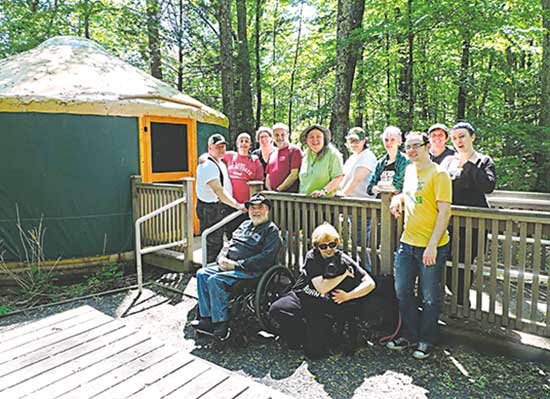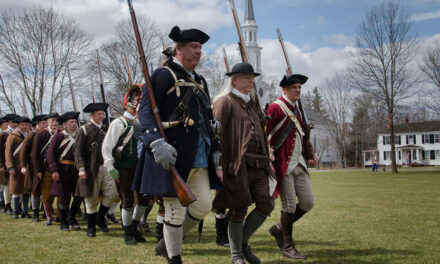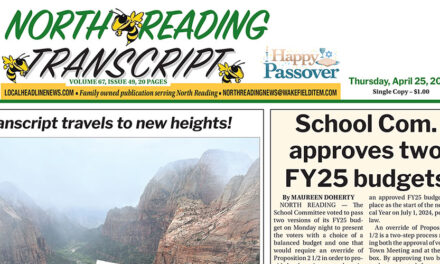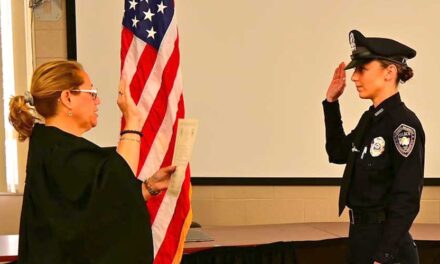Yurts at state parks make pastime universally accessible
Published in the August 16, 2018 edition
By MICHAEL GEOFFRION SCANNELL
NORTH READING — Although we live among the beauty of Martin’s Pond right here in North Reading, it was about four years ago that I was lamenting the fact that I hadn’t been camping in a really long time. My family had camped every summer when I was growing up somewhere near my grandfather’s house in Connecticut.
Our core group: Janet and Ed Nicosia, my wife Kathryn and I, Lori Lynes, and Larry Soucie and Donna Colebrook have been working together on projects for a long time. All of us were very involved in the Halloween-fests that happened at Clarke Park for over 20 years. We’ve become good friends. I’m not sure who, but someone in the group, discovered that the Massachusetts Department of Conservation and Recreation (DCR) has been putting up yurts at state forests and parks across the commonwealth. Through DCR’s Universal Access Program many of them are wheelchair accessible (to find out about accessible yurt camping and read a description of yurts and which parks provide them visit: https://www.mass.gov/service-details/accessible-camping).
Traditionally a yurt is a circular tent of felt or skins on a collapsible framework. They were used by nomadic tribes in Mongolia, Siberia and Turkey. A modern yurt is a circular, domed structure supported by a wooden frame and covered in canvas.
That was four years ago. We’ve now been to four different state parks and had four very unique and different experiences. All of us had different amounts of experience camping and different expectations going into this. Over the four years that we’ve been making these treks others have tagged along and/or dropped in, including our children, Declan and Brigid, Declan’s girlfriend Sam, and various siblings and roommates.

INTREPID CAMPERS at Wells State Park in Sturbridge in June 2016 included, back row from left: Ed and Janet Nicosia, Anne Ronco, Larry Soucie, Donna Colebrook, Kathryn Geoffrion Scannell, Caitlin Trudell, Declan Geoffrion Scannell, Robyn Scannell and Sam Tincler; foreground from left: Michael Geoffrion Scannell and Lori Lynes holding Maverick, the Nicosia family’s dog. (Courtesy Photo)
Larry Soucie, an avid hiker, wasn’t even sure that yurt camping qualified as “camping.” However, his wife, Donna Colebrook, commented, “It’s nice to have a bed.” Lori Lynes adds, “In a yurt all you need is a pillow and a blanket.” It was agreed we all enjoy the camaraderie.
Anne Ronco and her husband Scott have not slept in a yurt yet as they have chosen to tent camp during these outings. However, Anne admits, “It’s a nice place to have when it’s raining!”
Due to the scouting experience of several people in the group, we use a very specific “kaper chart” so each group of people or family knows which meals they are in charge of and when they have cleanup duty. This allows one to vacation guilt-free. My wife Kathryn said, “I like knowing that I cooked breakfast yesterday and have cleanup duty after dinner tomorrow. That way I can do what I want!”
Breakfast and dinner are provided as part of the trip and the costs divided. Everyone is on their own for lunch. All the money spent on food is added up and then divided by the number of meals. Janet keeps the books. We average just over $5 per meal per person on our camping trips and, believe me, we eat well.
Some people in the group take side trips; for others, the campsite is the destination. Small groups might go kayaking or visit a museum.
Willard Brook State Forest
The first year our destination was Willard Brook State Forest in Townsend. We didn’t want to be too far out and we went for little more than a long weekend in case it wasn’t fun. It was. We mostly hung around the camp, many of us sharing a 10-person yurt. The others were in tents. There was canoeing, kayaking and even some archery.
Wells State Park
Wells State Park in Sturbridge was not our finest hour. Rain and an infestation of leaf-eating caterpillars kept us close to our yurts. Not even Old Sturbridge Village was an option.

LONGTIME friends from the Martin’s Pond neighborhood embarked on their first yurt camping experience in June 2015 at Willard Brook State Forest in Townsend. Back row, from left: Ed and Janet Nicosia, Larry Soucie, Donna Colebrook, Anne and Scott Ronco, Kathryn Geoffrion Scannell; foreground: Lori Lynes with camping mascot Maverick Nicosia, and Michael Geoffrion Scannell. (Courtesy Photo)
October Mountain
Last year when we were out at October Mountain State Forest in Lee, which is right next to Lenox, home to Tanglewood. We attended a screening of “Jaws” with the actual Boston Symphony Orchestra playing the soundtrack live. It was fun! Lots to see out that way.
Shawme-Crowell
Shawme-Crowell State Forest in Sandwich was lovely and I don’t know of any place to stay on the Cape in June for just over $10 a night per person. Many day tripping possibilities… and great seafood.
Over the four years our stays have gotten longer. This summer we stayed a week. The Nicosias decided to reserve a yurt.
Buildings without barriers
An important point: The yurts are there for everyone’s use on a fair, first-come, first-served basis; non-wheelchair user as well. They’re simply buildings without barriers.
There are several different configurations of yurts at the various parks and several yurts on site at each one. If you go online, you’ll see when the camping season begins at the various state facilities (https://www.mass.gov/service-details/accessible-camping). You can book six months in advance through www.reserveamerica.com. Bathroom facilities vary at the various state parks.
MassDCR Universal Access Program Outreach Coordinator Laila Soleimani informs me that, “The Department of Conservation and Recreation’s Universal Access Program offers camping for campers of all abilities.
“Yurts are available for rent during the main recreation season. Our yurts have bunk beds, a table and chairs, and electricity. This electrical service is not reliable enough to use with medical devices and equipment.”
She elaborated, “Accessible yurt sites have firm, flat surfaces, an accessible picnic table, and an accessible pedestal grill.”
“While participants are camping, they’re welcome to enjoy other park activities,” Soleimani added. “For example, at Nickerson State Park in Brewster, the McGraw Center for Adaptive Sports offers accessible recreation programs so campers can have an adaptive recreation/sports experience, but also stay in a yurt and enjoy the beautiful park.”
She said Shawme-Crowell State Forest offers quiet accessible picnicking, and there’s an annual accessible Fishing Derby which takes place at Myles Standish State Forest in Plymouth. This year’s derby, the 12th annual event, is Saturday, September 29, open to all ages and does not require fishing licenses. Mass. Wildlife stocks the pond, and rods and bait are also provided free of charge.
As Soleimani began to talk about site improvements being one of the ways in which DCR provides adaptive recreation opportunities for visitors in our state parks and how they are constantly looking at where they are and what improvements need to be made, she said, “Campgrounds are one of the things we look at. It’s an ongoing effort. We’re very excited about the fact that the campground at Massasoit State Park is currently undergoing renovations and will re-open soon with some accessible RV and tent sites.”
Closer to home, Harold Parker State Forest in Andover is one of six state parks or forests that offer tent sites on firm and flat surfaces with accessible picnic tables and grills, but no yurts.
Soleimani added that readers who have any questions about adaptive recreation programs or accessible yurt camping, they’re welcome to get in touch her at 413-545-5759 or MA Dept. of Conservation and Recreation, Universal Access Program, Outreach Coordinator, PO Box 484, Amherst, MA 01004.
The Department of Conservation and Recreation’s Universal Access Program is also working with the Institute for Human Centered Design, a Boston-based nonprofit with a 40-year history dedicated to universal design, to get detailed audits of their parks.
When I spoke to Valerie Fletcher, executive director of the Institute for Human Centered Design (IHCD), she told me that the ADA, state laws and U.S. Forest Service Universal Design Regulations require programs to be accessible.
But how do we define a program? She conceded that if you schedule an adaptive kayaking class the parameters are easily defined. She went on to explain, “There are blind and low vision people birding in our state parks…identifying birds by sound. …This takes time. We need places for people to be comfortable for a while.”
Director Fletcher told me about one area where the main program seems to be watching the sunset. She said, “The whole town was going down at sunset. It was mobbed and officials had no idea,” adding, “If this is what brings people to the park, we have to make it accessible.”
Other aspects of the IHCD audits include elder issues and the challenge of providing accessibility for people on the Asperger’s spectrum. The results of these audits should enable DCR’s Universal Access Program to continually evolve and enable everyone to enjoy the state’s beautiful parks and forests.
Happy camping!




